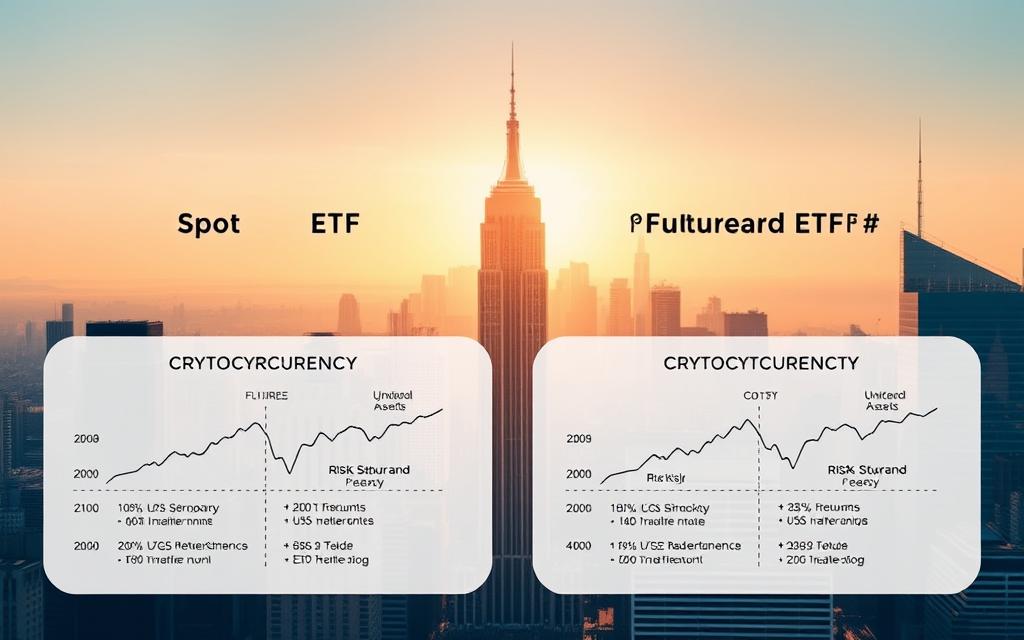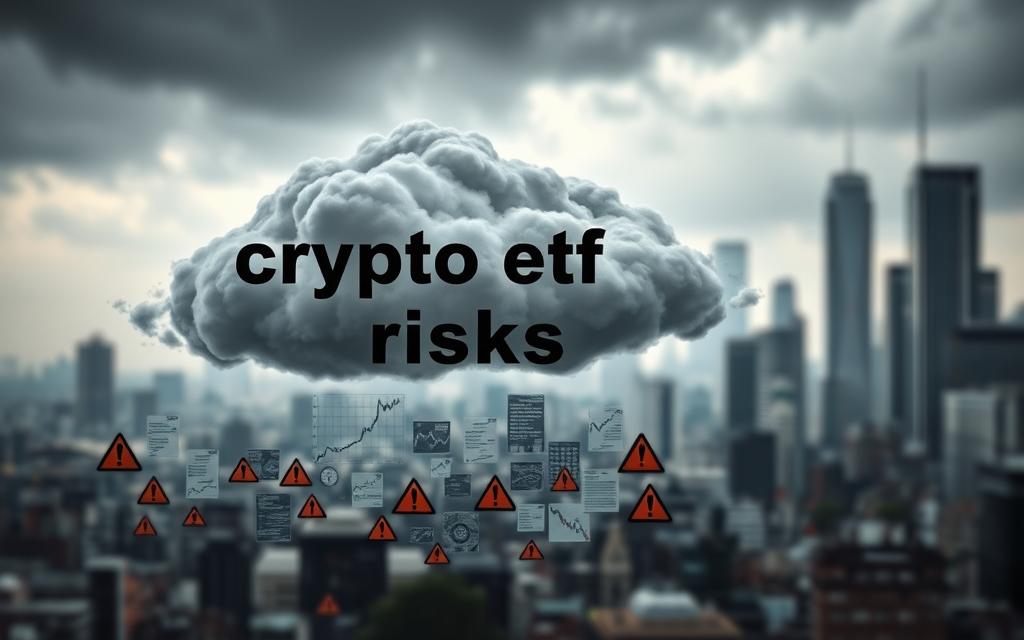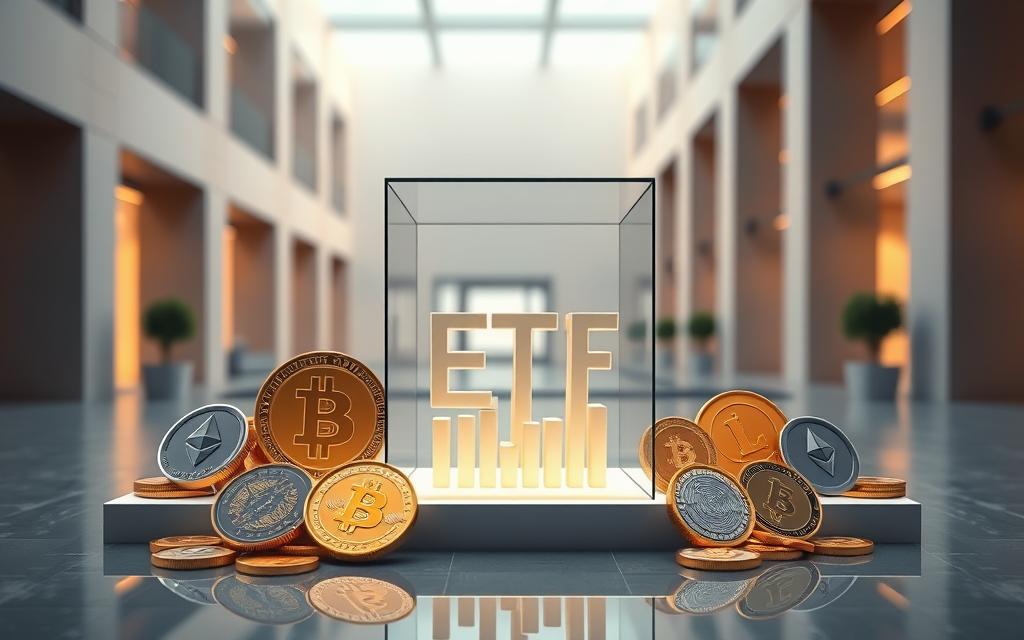Table of Contents
Exchange-traded funds for digital assets blend traditional investment structures with blockchain technology. These instruments allow exposure to cryptocurrency markets without direct ownership. The SEC’s 2024 approval of spot Bitcoin products marked a turning point for institutional adoption.
Major financial firms like BlackRock and Fidelity now offer regulated access through trusts such as IBIT and FBTC. Unlike holding coins in private wallets, these ETFs provide custodial security and familiar trading mechanisms. Saxo Group compares the process to “owning BTC without technical complexities.”
Canada’s $4.3 billion market demonstrates strong demand for hybrid solutions. These products serve as bridges between conventional finance and decentralized systems. Investors gain portfolio diversification while avoiding wallet management and private key risks.
What Is an ETF Crypto? Defining the Basics
Institutional-grade exposure to blockchain markets arrives through familiar structures. These products combine the oversight of traditional finance with the innovation of decentralized networks. Unlike conventional funds holding stocks or bonds, they track the performance of digital currencies.
Traditional vs Blockchain-Based Structures
Standard funds typically spread risk across hundreds of corporate securities. Purpose Investments’ BTCC demonstrates the single-asset focus, holding 24,530 BTC as collateral. Grayscale’s $28 billion holdings showcase the custodial requirements for these instruments.
Three critical differences define these modern assets:
- Underlying holdings: Physical BTC vs company shares
- Settlement times: Blockchain minutes vs T+2 days
- Management fees: 0.25-2.5% vs 0.03-0.75%
Operational Framework
NAV calculations incorporate real-time blockchain data rather than closing exchanges prices. Creation/redemption mechanisms require authorized participants to handle actual coin transfers. Schwab’s hybrid approach blends direct exposure with companies like MicroStrategy.
Custody solutions prevent the need for personal wallet management. This structure appeals to investors seeking blockchain growth without technical complexities. The system mirrors traditional fund operations while accommodating digital asset peculiarities.
How Do Crypto ETFs Work? Mechanics and Types
Modern portfolios integrate blockchain exposure via standardized structures. These products track digital asset performance while adhering to regulatory frameworks. Two primary variants dominate the market: spot and futures-based funds.

Spot ETFs vs. Futures ETFs
BlackRock’s IBIT exemplifies spot ETFs, holding actual BTC in audited cold storage. These funds mirror real-time price movements with 99.7% accuracy, as seen in ARKB’s performance.
Futures-based products like BITO suffer from contango drag. In 2022, this cost investors 18% due to rolling contracts. The 2024 YTD gap between IBIT and BITO highlights this: 23% underperformance.
| Metric | Spot ETFs (e.g., IBIT) | Futures ETFs (e.g., BITO) |
|---|---|---|
| Underlying Asset | Physical BTC | Derivative contracts |
| Tracking Error | 0.3% | 5-8% |
| Fees | 0.25% | 0.95% |
| Best For | Long-term holders | Short-term traders |
Tracking Cryptocurrency Prices
Over 90% of funds use the CME CF Bitcoin Reference Rate for NAV calculations. This index aggregates data from major exchanges like Coinbase and Kraken.
Ethereum’s shift to Proof-of-Stake cut operational costs by 40%. Grayscale’s ETH Mini Trust reflects this efficiency, holding 0.001 ETH per share.
Examples: Bitcoin and Ethereum ETFs
VanEck’s HODL (spot) and ProShares’ EETH (futures) showcase structural contrasts. The former offers direct exposure, while the latter uses CME derivatives.
ARKB’s 99.7% correlation to BTC price demonstrates near-perfect tracking. These examples prove hybrid solutions can replicate blockchain markets faithfully.
The Global Market Impact of Crypto ETFs
The 2024 ETF wave transformed how institutions engage with decentralized assets. Over $46 billion flooded US spot products within nine months, signaling unprecedented demand. This capital influx redefined liquidity dynamics across global markets.
SEC Approvals and Market Legitimacy
January’s landmark decision triggered a regulatory domino effect. UAE and Singapore fast-tracked similar products within weeks. Farside Investors data shows institutional participation reduced Bitcoin’s volatility by 22%.
Key developments include:
- Tether allocated 15% of its $110B reserves to ETF shares
- Canada’s Purpose ETF daily volume spiked 400% post-approval
- 47 major investors entered through 11 new US funds
Institutional Adoption and Liquidity
BlackRock integrated spot products into its Aladdin platform, enabling pension fund allocations. Fidelity now offers exposure via 401(k) windows, mirroring trends among institutional players.
Liquidity improvements are stark. GBTC’s bid-ask spread collapsed from 5% to 0.15% after conversion. As institutional investors increase participation, markets gain stability previously unseen in digital assets.
Benefits of Investing in Crypto ETFs
Retirement accounts now incorporate blockchain exposure through regulated channels. Charles Schwab’s platform enables investors to allocate 401(k) and IRA funds, with 17% growth in 2024. This access eliminates technical barriers while maintaining tax advantages.

Accessibility for Traditional Investors
Vanguard’s model portfolios now dedicate 2% to these instruments. Unlike unregulated ICOs, SEC-reviewed prospectuses provide transparency. Key advantages include:
- Familiar brokerage interfaces (e.g., Fidelity’s 401(k) windows)
- No private key management requirements
- Wash sale rules don’t apply to transactions
Regulatory Oversight and Security
Coinbase Custody safeguards $73B in assets with SOC 2 Type 2 compliance. BlackRock and Fidelity policies cover $1B against breaches. Regulatory frameworks ensure:
- Daily audits of cold storage reserves
- FDIC-insured cash components
- Real-time NAV calculations
Portfolio Diversification
Bitwise’s BITQ shows 35% non-correlation to the S&P 500. Since launch, Bitcoin’s 0.27 correlation coefficient enhances portfolio resilience. Diversification benefits include:
- Inflation hedge properties
- Exposure to blockchain growth sectors
- Reduced overall volatility
Risks and Challenges of Crypto ETFs
Investors face unique hurdles when navigating blockchain-based investment vehicles. While these products simplify access, they introduce exposure to market dynamics and policy shifts. Understanding these risks is crucial for informed decision-making.

Volatility and Tracking Errors
March 2024’s flash crash saw ETH funds trade 8% below NAV. Such price swings amplify tracking errors, especially during network congestion. Three ETFs halted creations in May 2024 when fees spiked 500%.
Key concerns include:
- Volatility: BTC’s 30-day swings averaged 4.2% in 2024, per Bitwise
- Bid-ask spreads: 0.02% for IBIT vs 1.7% OTC markets
- Concentration: Top 5 ETFs hold 89% of institutional BTC
Regulatory Uncertainty
The SEC’s probe into Tether-backed applications highlights ongoing risks. Proposed Rule 6c-11 changes could delay redemptions during market stress. Terra’s collapse still impacts staked ETH product approvals.
Critical developments:
- CFTC data shows ETF options volume at 30% of CME futures
- Concentration risk: Top 5 ETFs hold 89% of institutional BTC
- GBTC’s $642M June outflows signal sensitivity to policy shifts
Liquidity Risks
Unlike traditional assets, blockchain-based funds face settlement bottlenecks. During June’s correction, GBTC’s daily volume dropped 60%. Liquidity risks emerge when:
- Authorized participants pause creations (May 2024 incident)
- OTC markets widen spreads during volatility
- Tax events trigger mass redemptions
ARKB’s 0.02% spread demonstrates stability, but smaller funds face higher price impacts.
How to Invest in Crypto ETFs: A Step-by-Step Guide
Navigating blockchain-based funds requires understanding key selection criteria and execution methods. These regulated instruments offer exposure to digital assets through traditional brokerage accounts, simplifying the investment process for mainstream users.
Choosing the Right ETF
Fidelity’s screening tool provides 14 filters to evaluate options. Expense ratios vary significantly—FBTC charges 0.19% versus GBTC’s 1.5%. Consider these factors:
- Tracking method: Spot funds like IBIT outperform futures-based products
- Custodian reputation: Coinbase secures $73B in assets
- Liquidity metrics: ARKB maintains 0.02% bid-ask spreads
Schwab’s thematic lists highlight seven specialized strategies. Texas restricts public funds to 2% allocations, while EU’s MiCA limits retail access.
Brokerage Accounts and Platforms
Most major platforms now support these instruments. E*TRADE enables limit orders for products like BITO. Key steps include:
- Verify account type compatibility (taxable vs Roth IRA)
- Review minimum investment requirements
- Analyze creation/redemption mechanisms for arbitrage
Charles Schwab integrates these options into retirement accounts, with 17% growth in 2024 allocations.
Tax Implications
IRS Notice 2024-21 mandates Form 8949 for all sales. Unlike direct coin ownership, wash sale rules don’t apply. Consider:
- Long-term vs short-term capital gains treatment
- State-specific reporting requirements
- Cost basis tracking challenges with frequent trades
Proactive planning prevents surprises during tax season. Consult a professional for complex situations.
The Regulatory Landscape for Crypto ETFs
Governments worldwide are shaping policies for blockchain-based investment products. These frameworks balance innovation with investor protection, creating distinct regulatory environments across regions. Recent developments show accelerating adoption alongside evolving compliance standards.

Current US Regulations
The SEC maintains strict oversight through Accounting Bulletin 121. This rule requires custodians to list digital assets as liabilities on balance sheets. Gary Gensler’s “enhanced disclosures” mandate includes:
- Daily proof-of-reserves audits
- Transparent fee structures
- Clear risk disclosures about blockchain technology
Nineteen approved US funds operate under these guidelines. The CFTC-SEC jurisdiction battle over Ethereum classification remains unresolved, creating uncertainty for future products.
Comparisons with Global Markets
Canada leads with 40 approved funds, while Hong Kong attracted $2B in its first month. Key differences emerge in regional approaches:
| Region | Approval Process | Unique Requirements | Market Impact |
|---|---|---|---|
| United States | SEC review (6-18 months) | Accounting Bulletin 121 compliance | $46B inflows in 2024 |
| Canada | Exemptive relief orders | Monthly custody attestations | $4.3B AUM |
| European Union | DLT Pilot Regime exemptions | MiFID II light-touch rules | 17 cross-border funds |
Brazil’s B3 exchange recently launched an options market for these instruments. Basel III rules now permit banks to hold limited ETF shares as tier-2 capital.
Future Regulatory Trends
2025 projections suggest divergent paths based on US election outcomes. A Democratic administration may expand disclosure rules, while Republican leadership could streamline approvals. Emerging developments include:
- Potential ETH classification as commodity (CFTC) vs security (SEC)
- DLT settlement pilots exempt from traditional T+2 rules
- Tax treatment harmonization across G20 nations
The EU’s Markets in Crypto-Assets (MiCA) framework will fully implement in 2026. This creates standardized rules for global markets, potentially influencing US policy directions.
Conclusion: Are Crypto ETFs Right for You?
Deciding whether these investment vehicles fit your strategy requires careful evaluation. Assess your risk tolerance—these assets often swing 18% or more within weeks. Morningstar suggests capping exposure at 5% of liquid net worth.
Recent 63% gains tempt performance chasers, but sustainable growth demands discipline. Automated tools like M1 Finance help implement dollar-cost averaging. Blend regulated products with direct holdings for balanced exposure.
Consult a fiduciary before adjusting allocations. These instruments offer simplified access, but require understanding their unique dynamics. Balance potential rewards against volatility when building your portfolio.
FAQ
How do traditional ETFs differ from crypto ETFs?
Traditional ETFs track stocks, bonds, or commodities, while crypto ETFs focus on digital assets like Bitcoin or Ethereum. Both trade on exchanges, but crypto ETFs deal with higher volatility.
What are the main types of crypto ETFs?
The two primary types are spot ETFs, which hold actual cryptocurrencies, and futures ETFs, which track derivatives contracts tied to crypto prices.
Why are crypto ETFs gaining popularity?
They offer traditional investors easy exposure to digital currencies without managing private keys or wallets. Regulatory approvals, like the SEC’s Bitcoin ETF greenlight, also boost credibility.
What risks come with crypto ETFs?
Key risks include price volatility, regulatory shifts, and tracking errors—where the ETF’s performance doesn’t perfectly mirror the underlying asset.
How can I start investing in crypto ETFs?
Open a brokerage account on platforms like Fidelity or Charles Schwab, research ETFs like ProShares Bitcoin Strategy (BITO), and allocate funds based on your risk tolerance.
Are crypto ETFs taxed differently than stocks?
In the U.S., they’re taxed as property, meaning capital gains rules apply. Short-term holdings (under a year) face higher rates than long-term.
Which countries lead in crypto ETF adoption?
Canada approved the first Bitcoin ETF (Purpose Bitcoin ETF) in 2021. The U.S. followed in 2024, while Europe and Asia have stricter regulatory hurdles.
Do crypto ETFs improve market liquidity?
Yes. By attracting institutional investors, ETFs increase trading volumes and reduce bid-ask spreads, making markets more efficient.









